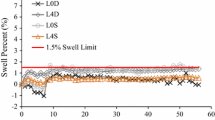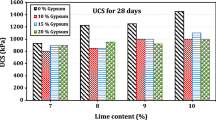Abstract
Stabilization of expansive soils using lime and cement additives have been used by practitioners over the years. However, recent heaving and premature pavement failures in lime and cement-treated subgrades containing sulfates led to questioning the use of calcium-based stabilization methods for these soils. Annually, millions of dollars are spent to repair pavements distressed by this Ettringite induced heaving. Based on the past studies, researchers and practitioners have proposed various methods to treat sulfate soils. Applicability of these methods is mostly limited to soils with sulfate levels below 8000 ppm. Soils with sulfate content above 8000 ppm are termed as “high sulfate” soils, and chemical treatment of such soils is currently not considered. A research study was designed to aid in understanding the heaving phenomenon in soils with sulfate contents above 8000 ppm and to develop practical techniques to stabilize such soils. High sulfate soils were sampled and treated with lime at varying mellowing periods and treated soils were then subjected to the engineering and chemical tests. Tests results were analyzed to understand the effectiveness of mellowing period on the heaving phenomenon of these soils. Treated soils at higher mellowing periods showed reduced sulfate-induced heaving when sulfate levels are lower than 30,000 ppm. Sulfate levels in excess of 30,000 ppm did not result in effective treatment of soils. It was also observed that compaction void ratios and soil clay mineralogy have a significant impact on the swell behavior of chemically treated high sulfate soils. An innovative method comprising of aerial technologies is used to monitor the pavement heaving. This keynote paper provides a comprehensive review of stabilization of high sulfate soils and methods studied to mitigate sulfate heaving.










Similar content being viewed by others
References
Berger E, Little DN, Graves R (2001) Technical memorandum: guidelines for stabilization of soils containing sulfate. http://www.lime.org/publications.html. Accessed September 2010
Carter DL, Heilman MD, Gonzales CL (1965) Ethylene glycol monoethyl ether for determining surface area of silicate minerals. Soil Sci 100:356–360
Chapman HD (1965) Cation-exchange capacity 1. In: Black CA et al. (ed) Methods of soil analysis. Part 2—Chemical and microbiological properties. American Society of Agronomy, Madison, WI, pp 891–901
Chen FH (1988) Foundations on expansive soils. Dev Geotech Eng 12:12
Chittoori B, Puppala AJ (2011) Quantitative estimation of clay mineralogy in fine-grained soils. J Geotech Geoenviron Eng 137(11):997–1008
Dermatas D (1995) Ettringite-induced swelling in soils: state-of-the-art. Appl Mech Rev 48:659–673
Eades JL, Grim RE (1966) A quick test to determine lime requirements for lime stabilization. Highw Res Rec 139:61–72
Foster HM (1953) Geochemical studies of clay minerals III. The determination of free silica and free alumina in Montmorillonites. Geochem Cosmochim Acta 3:143–154
Freese K, Abbas A, Senko J, Cutright TJ (2015) Assessment of process variables that can impact results of soluble sulfate evaluated by the Tex-145E method. J Test Eval 43(6):1472–1478
Harris JP, Von Holdt J, Sebesta S, Scullion T (2006) Recommendations for stabilization of high-sulfate soils in Texas. Transportation Research Record No. 1952. TRB, National Research Council, Washington, DC, pp 71–79
Hausmann MR (1990) Engineering principles of ground modification. McGraw–Hill, New York
Hunter D (1989) The geochemistry of lime-induced heave in sulfate bearing clay soils. In: Ph. D. Dissertation, University of Nevada, Reno
Hunter D (1988) Lime-induced heave in sulfate-bearing clay soils. J Geotech Eng ASCE 114:150–167
Kota BVS (1996) Sulfate bearing soils: problems with calcium based stabilizers, vol 1546. Transportation Research Record. National Research Council, Washington, DC, pp 62–69
Knudsen D, Peterson GA, Pratt PF (1982) Lithium, sodium, and potassium. In: Page AL (ed) Methods of soil analysis. Part 2—Chemical and microbiological properties. American Society of Agronomy, Madison, WI, pp 225–246
Little DN, Nair S, Herbert B (2010) Addressing sulfate-induced heave in lime treated soils. J Geotech Geoenviron Eng ASCE 136:110–118
Mehta PK (1973) Effect of lime on hydration of pastes containing gypsum and calcium aluminate or calcium sulfoaluminate. J Am Cer Soc 56:315–319
Mitchell JK, Dermatas D (1992) Clay soil heave caused by lime-sulfate reactions. ASTM Spec Publ 1135:41–64
Mitchell JK, Soga K (2005) Fundamentals of soil behavior. Wiley, New York
Mitchell JK (1986) Practical problems from surprising soil behavior. J Geotech Eng Div ASCE 112(3):259–289
Nelson DJ, Miller JD (1992) Expansive soils: problems and practice in foundation and pavement engineering. Wiley, Hoboken, p 259
Ogawa K, Roy DM (1982) C4A3S hydration, ettringite formation and its expansion mechanism: part II, microstructural observation of expansion. Cem Concr Res 12:101–109
Perrin L (1992) Expansion of lime-treated clays containing sulfates. In: Proceedings of 7th international conference on expansive soils, ASCE Expansive Soil Research Council, New York, vol 1, pp 409–414
Petry TM, Little DN (1992) Update on sulfate induced heave in treated clays: problematic sulfate levels. Transportation Research Board, TRR 1362, Washington, DC
Puppala A, Musenda C (2000) Effects of fiber reinforcement on strength and volume change in expansive soils. Transp Res Rec J Transp Res board 1736(1):134–140
Puppala AJ, Hanchanloet S, Jadeja M, Burkart B (1999) Sulfate induced heave distress: a case study. In: Proceedings, transportation research board annual meeting, Washington DC, USA
Puppala AJ, Viyanant C, Kruzic AP, Perrin L (2002) Evaluation of a modified soluble sulfate determination method for fine-grained cohesive soils. Geotech Test J GTJODJ 25(1):85–94
Puppala AJ, Wattanasanticharoen E, Punthutaecha K (2003) Experimental evaluations of stabilization methods for sulphate-rich expansive soils. Ground Improv 7(1):25–35
Puppala AJ, Katha B, Hoyos LR (2004) Volumetric shrinkage strain measurements in expansive soils using digital imaging technology. ASTM Geotech Test J 27(6):547–556
Puppala AJ, Intharasombat N, Vempati R (2005) Experimental studies on ettringite induced heaving in soils. ASCE J Geotech Geoenviron Eng 31(3):325–337
Puppala AJ, Wattanasanticharoen E, Punthutaecha K (2005) Experimental evaluations of stabilisation methods for sulphate-rich expansive soils. Proc Inst Civ Eng Ground Improv 9(2):89–90
Puppala AJ, Talluri NS, Chittoori BS, Gaily A (2012) Lessons learned from sulfate induced heaving studies in chemically treated soils. In: Proceedings of the international conference on ground improvement and ground control. Research Publishing, pp 85–98
Puppala AJ, Congress SSC, Bheemasetti TV, Caballero S (2018) Visualization of civil infrastructure emphasizing geomaterial characterization and performance. ASCE J Mater. https://doi.org/10.1061/(ASCE)MT.1943-5533.0002434
Puppala AJ, Congress SSC, Bheemasetti TV, Caballero S (2018) geotechnical data visualization and modeling of civil infrastructure projects. In: GeoShanghai international conference, pp 1–12, Springer, Singapore
Talluri N, Gaily A, Puppala AJ, Chittoori B (2012) Comparative study of soluble sulfate measurement technqiues. In: GeoCongress 2012, Oakland CA March 2–29, GSP 225, pp 3372–3381
Talluri N et al (2013) Stabilization of high sulfate soils by extended mellowing. Transportation Research Board Annual Meeting, Washington, DC
Acknowledgements
Authors would like to thank Joe Adams of TxDOT, Jimmy Si of TxDOT, Wade Blackmon of TxDOT Paris District and Richard Williammee of Fort Worth District, for their guidance, support and supervision through the project time period. We acknowledge the funding support from TxDOT for the project.
Author information
Authors and Affiliations
Corresponding author
Rights and permissions
About this article
Cite this article
Puppala, A.J., Talluri, N., Congress, S.S.C. et al. Ettringite induced heaving in stabilized high sulfate soils. Innov. Infrastruct. Solut. 3, 72 (2018). https://doi.org/10.1007/s41062-018-0179-7
Received:
Accepted:
Published:
DOI: https://doi.org/10.1007/s41062-018-0179-7




